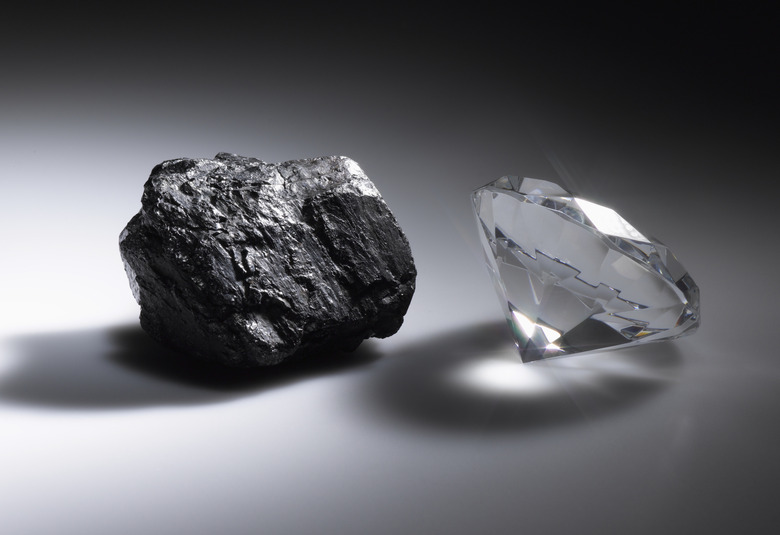The Process Of Changing A Rock By Extreme Heat & Pressure
People commonly associate the transformation of rocks with heat and pressure with the creation of diamonds. Diamonds, however, represent only one form of metamorphism. Some metamorphic rocks are produced by high pressure and low heat, others primarily by extreme heat and water. The sources of heat and pressure can vary as well — which can include burial and earthquakes, and have a significant impact on how a rock is transformed.
Metamorphic Agents
Metamorphic Agents
The three factors that contribute to metamorphism are heat, pressure and the presence of chemically active fluids. Heat can result from any combination of three separate sources: radioactivity, the friction of tectonic plates sliding past one another or from gravity's constant compressive force. Pressure can arise from direct application, such as the force of one tectonic plate pressing against a rock. Pressure can also build upon a buried rock in the form of gravity, which pulls tons of material downward against that rock. The most common active fluid in metamorphism is water, which circulates through rocks as they heat up, and fosters chemical exchanges between its molecules and the molecules of the rock.
Types of Metamorphism
Types of Metamorphism
Just as there are three agents that affect metamorphism, there are three general types of metamorphic processes: dynamic metamorphism, contact metamorphism and regional metamorphism. Dynamic metamorphism is the least common form of metamorphism, and is a pressure-based process that occurs mostly along fault lines. Heat and fluids don't play a significant role here. This process produces rocks such as mylonite, which have distinctive linear textures. Contact metamorphism, conversely, utilizes heat and fluids instead of high pressure. This is also known as hydrothermal metamorphism, and produces many gems and minerals, such as copper and silver. Regional metamorphism is the process that incorporates both high pressure and high heat, and is responsible for producing diamonds. Regional metamorphism is usually the product of burial heat and pressure.
Metamorphism and The Rock Cycle
Metamorphism and The Rock Cycle
The rock cycle is the series of transformative processes rocks experience, and the different forms they take. Metamorphism is only one process in this cycle, but it's foundational in that it prepares sedimentary rocks to be melted back down into magma, after which that magma can re-cool to form new igneous rock. In this context, metamorphism can be viewed as a process that concentrates the components of rocks, similar to a trash compactor, before it is incinerated deep beneath the Earth's crust.
Influence of Origin
Influence of Origin
Aside from the factors of pressure, heat and water, the mineral composition of an igneous rock also contributes to results of metamorphism. The effects of original composition manifest in a rock's texture, and geologists use this quality of texture to categorize these rocks. Foliated rocks are those that display distinct linear features in their physical composition, which are a direct result of the high pressure of regional metamorphism. Slate, phyllite and schist are examples of foliated rocks. Non-foliated metamorphic rocks, conversely, don't exhibit any linear or planar texturing — or foliation, which indicates that these rocks were formed from the heat of contact metamorphism. Marble is an example of non-foliated metamorphic rock.
Cite This Article
MLA
Cascio, Christopher. "The Process Of Changing A Rock By Extreme Heat & Pressure" sciencing.com, https://www.sciencing.com/process-changing-rock-extreme-heat-pressure-14772/. 24 April 2017.
APA
Cascio, Christopher. (2017, April 24). The Process Of Changing A Rock By Extreme Heat & Pressure. sciencing.com. Retrieved from https://www.sciencing.com/process-changing-rock-extreme-heat-pressure-14772/
Chicago
Cascio, Christopher. The Process Of Changing A Rock By Extreme Heat & Pressure last modified March 24, 2022. https://www.sciencing.com/process-changing-rock-extreme-heat-pressure-14772/
